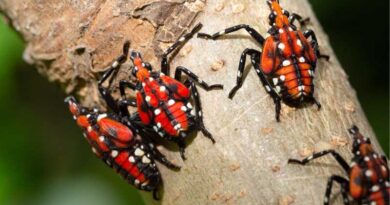Spotted lanternflies are rampant in New York City but how do we stop them?
25 October 2023, New York: Across New York City, large marks and smears of red-like paint are lining the streets. They’re appearing throughout tourist hotspots like Times Square and Central Park. From roads to pavements, even within supermarkets. These marks are the remains of the spotted lanternfly (Lycorma delicatula).
An infestation first appeared in New York in 2020. However, since 2014, the pest has spread throughout America, with neighbouring Pennsylvania seeing the worst infestation.
‘See it, squash it, report it’ is the campaign that has been ringing around America’s northeastern states for some time now. Alarmingly, the warmer spring in New York City this year has accelerated the spotted lanternfly’s development. This means they are a couple of weeks ahead compared to previous years.
The invasive species is lining New York’s subway system, residential housing, offices, and parks. The streets are becoming somewhat of a graveyard for the spotted lanternfly. Below, you can see the scale of the impact on the city.
Where do spotted lanternflies originate from?
Originating from China, adults are characterized by their grey forewings lined with dark spots and venation at the wing’s tips. Their hindwings are red at the base, lined with black and white above.
The pest could be mistaken for a butterfly or moth due to its colourful nature. However, lanternflies are not flies either, but insects known as planthoppers. Adults can be found as early as July and remain active until the first hard frost of the year, usually in November.
They are yet to be found in continents other than North America and Asia, although there is a deep concern that they will appear in the future.
A recent study indicates that other areas of the globe provide ideal climate conditions for the lanternfly to thrive such as southern Australia, southern regions of South America and large parts of Europe. Although, the study revealed that tropical habitats are not suitable for lanternflies to establish.
Several environmental variables were studied to predict the potential distribution of the pest. The environmental landscape in eastern regions of the U.S. is considered as ‘highly suitable’ for lanternfly distribution.
Female lanternflies accumulate eggs in large clusters on tree trunks and branches. Although, in New York City, egg masses have also been found on urban structures such as road signs, under vehicles and housing estates.
The impact of spotted lanternflies on New York City and the U.S.
As the pest spreads, it has the potential to wreak havoc on crops and other vital agricultural resources. The spotted lanternfly feeds on the sap of over 70 different kinds of plants and trees in the U.S. alone.
While they pose no risk to humans, lanternflies are a major agricultural pest, damaging crops like maple, hops, and grapevines.
Since appearing in the US in 2014, there has been a constant cycle of counties in several states placed under quarantine.
Pennsylvania has been the worst-hit state over the years. Mainly, the wine industry has seen significant economic losses. The sap-sucking pest could cost the state at least $324 million per year and eliminate 2,800 jobs, according to a study published by Penn State economists in 2019.
One farmer experienced a loss of 15% of the vineyard, translating to around $525,000 (£420,000) worth of product a year. Its sugary excrement and sooty mould have devastated the Pennsylvania wine industry – reportedly causing a 90% grape loss.
Vineyard farmers in Long Island have been on high alert since these attacks. However, the bug has so far not adversely affected New York’s wine industry. For many farmers in this region, it’s as though they’re waiting for the spotted lanternfly to arrive. An infestation is inevitable. The question is when?
How are spotted lanternflies and the tree of heaven interlinked?
A significant reason for the influx of spotted lanternflies in New York City is down to the tree of heaven (Ailanthus altissima). The noxious weed outcompetes native plants vital for a functioning ecosystem and wildlife habitat.
Not only do they crowd out native vegetation, but they also produce allelochemicals that may inhibit the growth of neighbouring plants. Their roots also damage the surrounding infrastructure. The tree of heaven is thriving in New York and across the US; it’s found in all but eight states. And the spotted lanternfly has a taste for it. The tree is a haven for the invasive lanternfly.
Limiting the spread and occurrence of the tree of heaven may slow spotted lanternfly spread and subsequently protect other plants.
Since 2020, CABI has been working with the Biotechnology and Biological Control Agency (BBCA) in Italy on a potential biological control agent for tree of heaven, an eriophyid mite.
The mite, initially identified as Aculus mosoniensis, now recognized as Aculus taihangensis, can be an effective biological control agent. However, further testing will be required before approval is given to release the mite into North America.
So how do we prevent this pest from spreading?
Besides the ‘See it, squash it, report it’ campaign, New Yorkers have also been advised to destroy the pest’s eggs. An egg clutch, containing between 30 to 50 eggs, can survive months of extreme weather.
A variety of chemicals have been shown to have some control. Unfortunately, current methods to control this pest are costly, time and labour-intensive, and limited in scope.
Management of spotted lanternfly remains dependent on chemical use, although there are promising biological control agents. Continued research of biological control agents will need to continue as outbreaks spread throughout the U.S. to curb the destruction of this pest.
In terms of total eradication in New York City and the rest of the U.S., it looks as though it’s too late. Now, the focus is on how spotted lanternflies can be kept to a tolerable level and prevented from spreading further.
Residents have also been advised to use at-home control methods to fight the invasion. For example, using circle traps, which use screening around the trunk of a tree, and funnels climbing spotted lanternflies into a container. Other methods include vacuum removal and insecticides.
Also Read: Innovative Label Design: Revolutionizing Agrochemical Packaging in India
(For Latest Agriculture News & Updates, follow Krishak Jagat on Google News)















